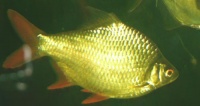Red-Tailed Tinfoil Barb (Barbonymus altus)
From The Aquarium Wiki
Red-Tailed Tinfoil Barb
Barbonymus altus
246 Litres (65 US G.)
18-20 cm (7.1-7.9")
Freshwater
6.5 - 7.5
22 -27 °C (71.6-80.6°F)
6-16 °d
1:1 M:F
8-12 years
Family
Cyprinidae
Contents
Additional names
- Red-Tailed Tinfoil Barb
Additional scientific names
- Barbodes altus, Barbodes foxi, Barbus altus, Puntius altus
Origin[edit]
- Found in the Mekong and Chao Phraya basins and has also been recorded from the Maeklong, Peninsular and south east Thailand river systems.
Sexing[edit]
- There are no external differences between male and female of this species. However, the female appears fuller when it is in spawning condition.
Tank compatibility[edit]
- A large peaceful shoaling fish that should be kept in groups of at least 4 or 5. Do not keep with very small fish nor with long-finned slow-moving fish such as Angelfish as this Barb may nip and will eat any fish that can fit in its mouth.
Diet[edit]
- In the wild, this Barb often invades flooded rice patties and eats the crop. It appreciates vegetable matter but is reluctant to eat floating vegetables. These fish like peas, zucchini and cooked rice. It will eat any fish or invertebrate small enough to fit in it's mouth. It greedily accepts all aquarium foods. As with most Cyprinids, the Red-tail will continue to eat until there is no food left; it does not register being "full." An occasional treat of live prey could be provided such as brine shrimp, but some younger specimens are too timid to accept these foods before their tank-mates have eaten the last one.
Feeding regime[edit]
- It will eat as long as there is food. 2-3 meals per day is sufficient; but it is a large hungry fish that needs plenty of food to thrive.
Environment specifics[edit]
- In the wild, B altus is a river dwelling species. Most of the environment is composed of rocks and pebbles. It does best in a large aquarium with plenty of filtration and water movement. Low oxygen levels will kill this fish before any other fish have a problem. It often eats live plants and certain types of algae. These fish are not too picky as to PH (they are very hardy) but show better colour and have more success with breeding in soft, slightly acidic to neutral water. Avoid sharp décor, it is sometimes startled and may injure itself. It does not hide as it feels that fleeing is a better defence.
Behaviour[edit]
- B. altus is a mid-bottom dweller. They are an active schooling barb that likes to be kept in numbers of at least 4-5 of it's own kind. It accepts new shoal members and will school with Barbonymus schwanenfeldii and other similar looking fish. They are generally peaceful but sometimes nip at long-finned slow moving fish, especially if it is kept as a single specimen. Like most fish, the Red-Tail Tinfoil barb will eat any fish small enough to fit in it's mouth. Keeping a more aggressive fish than them can make them more peaceful. Barbonymus altus are easily startled by sudden movements especially during the first few months in a new aquarium, and may injure their nose on the glass or sharp décor. This fish will jump if they are startled. It is a relatively easy species to keep in a large community tank. This Barb will come to recognize their owner and will "beg for food" by swimming along the front glass at high speeds.
Identification[edit]
- A large fish, has iridescent silver scales across the high-backed body, the fins are red. Can be mistaken for Barbonymus schwanenfeldii, the B. schwanenfeldii has black lines and markings in the finnage, whereas B. altus does not.
Pictures[edit]
External links[edit]
- Fishbase (Mirrors:
 )
)
